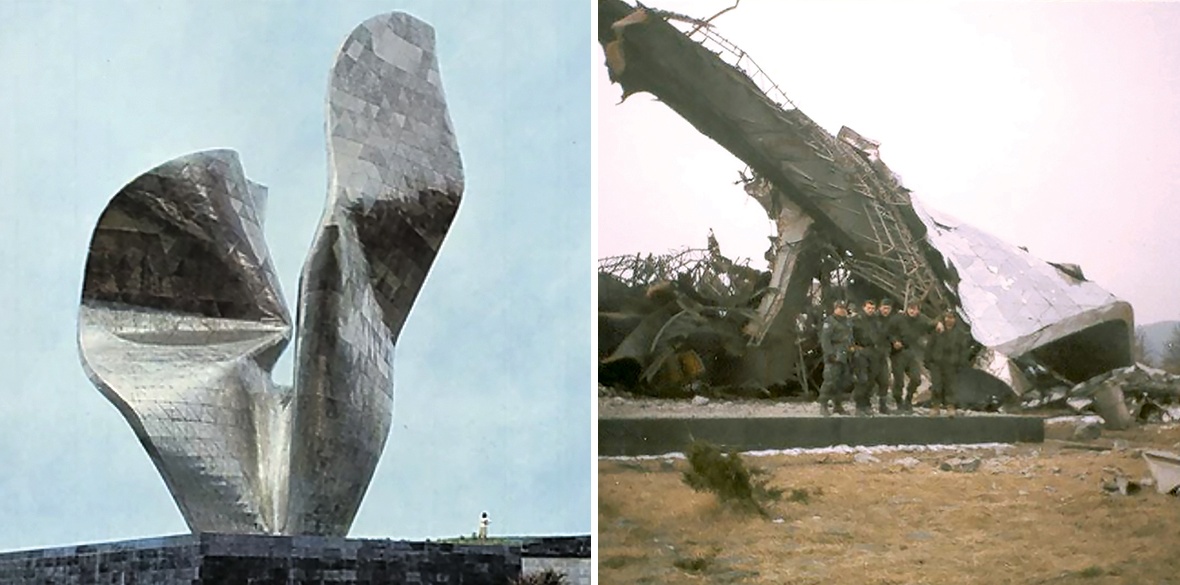This is the last article you can read this month
You can read more article this month
You can read more articles this month
Sorry your limit is up for this month
Reset on:
Please help support the Morning Star by subscribing here
BETWEEN 1945 and 1960 the Yugoslav socialist state commemorated the multinational anti-fascist armed resistance on its territory during WWII with a series of spectacular modernist memorials, better known as “spomeniks” — a striking book about which was reviewed in the Star on November 13 2018.
That partisan war lead to the liberation of the Nazi-occupied territories and the creation of one of the most successful multi-ethnic, multi-faith and multi-national political constructs achieved by humankind since the days of Cyrus the Great of Persia in the 6th century BC.
The gigantic memorials’ abstract expressionist style — a bold, avant-garde move away from prevailing socialist realism — created breathtaking, open-air scenarios not only for mass remembrance gatherings but also as welcoming places to visit at all other times.
One of the most striking of them stood on Blazuj Hill in Kamenska, Croatia. It was designed by Croat sculptor of Serbian descent Vojin Bakic to mark the “Revolutionary Victory of the People of Slovenia” when the partisan units liberated, in the summer of 1943, the Pozega Valley. On November 9 that year these detachments were consolidated in the 6th Slavonian Corps, an date celebrated to this very day by Croatian and Slovenian anti-fascists.
Bakic’s stainless steel “tour de force” stood 30 metres tall and at the time of its unveiling in November 1968 — to mark the 25th anniversary — it was the largest modernist sculpture in the world. Its polished surface panels subtly alternating between concave and convex would reflect sunlight in a multitude of directions, creating a luminous and joyous constructivist entity symbolising the aspiration to a better future.
It matters not if its shape alludes to the winged Nike of Samothrace, a raising Phoenix or an eagle as has been suggested. Bakic at the time studied “foliated forms” and might very well have employed an idea of a blossoming flower with opening petals that encapsulates life’s rebirth after the fascist holocaust.
It was this gentility of form and its balletic elegance that impacted the most as it addressed optimistically the future rather than dwelling in the past.
Sadly, in a dire historic warning, the sculpture was blown to pieces over five days in February 1992 most likely, according to Croatia’s Anti-fascist Journal, by fascistic and nationalist elements of the 123rd Pozeska Brigade of the Croatian army. The imbecilic local press blamed it on “excessive winds.”
The inscription on its base read: “To the liberation of the homeland and the victory of the socialist revolution that symbolises freedom and gratitude to the participants and the fallen in this struggle led by the Communist Party – raised by the people of Slavonia.” This alone must have infuriated Croatia’s new masters, the ultra-nationalist and revanchist inheritors of Ante Pavelic’s legacy of xenophobia, nationalist separatism and ethnic cleansing by mass murder.
The Croat art community, however, was shocked and outraged as it considered Bakic’s work to be one of the most important pieces of Croatia’s 20th century art. Nevertheless, all in all around 3,000 spomeniks were destroyed in Croatia since its independence in a cultural vandalism and intolerance that is but a hallmark of fascism.
Michal Boncza
The Spomenik Monument Database by Donald Niebyl is available (£22.50) at fuel-design.com/publishing/spomenik-monument-database.








